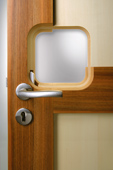Mar 20 2009
BASF's Palusol® SW fire-protection panels have now been certified according to the British standard: fire-protection doors made with Palusol SW have been successfully tested for their capacity to withstand fire for 30 and 60 minutes. Thanks to the approval obtained by BASF, door manufacturers that supply markets with British fire-protection standards can now save money when it comes to their own development work and the statutory fire-safety testing of their doors. They also need fewer resources to expand their design lines. In Europe, door manufacturers have to test the fire safety of every type of door. The stipulations vary from country to country.

Purchasing advantage for door manufacturers
With the British approval of Palusol SW, that is to say, Palusol fire-protection panels as a sandwich system with high-density fiberboard (HDF), different types of doors can be produced and different fire-protection stipulations can be met. The certificates pertain to British Standard 476 (Part 22) and apply to single-leaf and double-leaf doors. All of the certificates are based on the testing of real paneled doors (flat or raised and fielded). The door systems that withstand fire for 30 and 60 minutes were tested and certified in softwood layout.
Only HDF panels belonging to Emission Class E1/E0 and having a formaldehyde limit value of 0.1/0.05 ppm go into Palusol SW. BASF works with Palusol processors in the United Kingdom, so that the intumescent fire-protection materials can be obtained from a single source. This translates into a purchasing advantage for the door manufacturers.
Further certificates
In other countries, various types of Palusol sandwich systems have already been successfully fire-tested in their entirety or in their constituent parts. For instance, certain Palusol SW panels developed specifically for the United States have been certified to resist fire for 20 to 90 minutes.
Preventive fire protection
Palusol fire-protection panels have been officially approved for use in construction for over 30 years; they are rated A2 in accordance with German standard DIN 4102 and provide passive fire protection, for example, in fire doors, fire-retardant glazing, safety cabinets and fireproof bulkheads. Palusol consists essentially of sodium silicate and glass fibers that are coated with epoxy resin and cured. At temperatures above 100°C [212°F], the panels expand under foaming pressure, giving rise to a fine-cell, compression-resistant, non-flammable and thermally insulating foam. This foam then fills joints and gaps, thus preventing the propagation of heat, fire and smoke for a certain period of time. Palusol SW is available in different combinations, ranging from a Palusol panel with a single HDF to multi-layered sandwich structures.